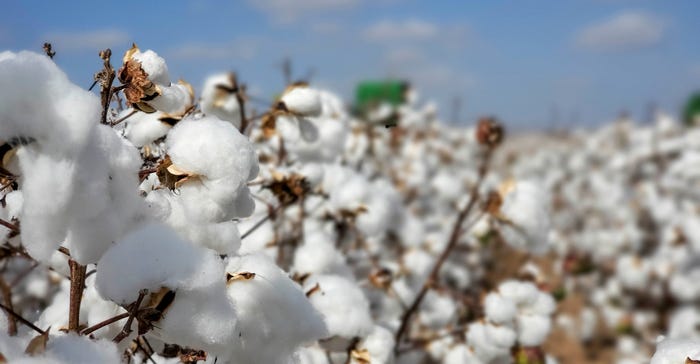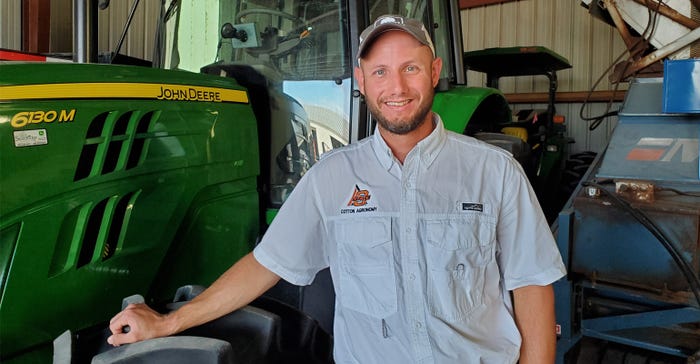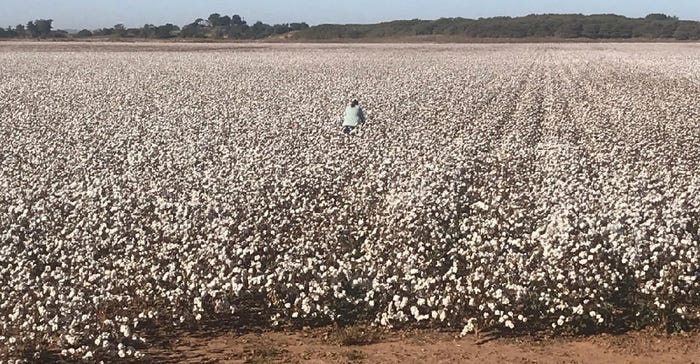
Oklahoma cotton farmers find themselves in an unusual situation as they complete harvest this fall. Yields are mostly good, and prices are excellent.
“Cotton price is still above a dollar a pound,” said Altus, Okla., farmer Clint Abernathy. “It’s stayed at that price for quite a while.”

“We’ve been really blessed,” said Frederick farmer Joe D. White. “We’re getting a good price for cotton. It’s a wonderful situation.
“I don’t expect it to hold for next year,” he added, but said it is unusual for a good crop to occur at the same time as good prices.
Good Crops
Both he and Abernathy are looking at good yields.
“Yields are pretty good,” Abernathy said. “Irrigated cotton, compared to what I expected early, is really good. I thought it would be a disaster with low lake levels. But beneficial rain in July pushed the lake up. It’s not a huge, bumper crop but a good average yield. Dryland is making in the one-bale range, some a bale-and-a-half. I think dryland will average about a bale to a bale-and-a-quarter.”
“We’re still harvesting a pretty good crop,” White said. “We are finished with the irrigated crop and about half done with dryland.
“It is a record irrigated crop for me,” he said. “I’ve never had one that good before. Dryland is good, maybe not a record, but good.”
 Joe D. White's personal record irrigated crop. (Photo by Joe. D White)
Joe D. White's personal record irrigated crop. (Photo by Joe. D White)
White said timely rains helped dryland cotton. “And we have an excellent water resource for irrigation. We irrigate from wells, and they were strong this year. Wet winters the last couple of years helped a lot.”
“We’re just about done,” Abernathy said. “We would have been done a week ago (around Nov.10) but replanted acreage dragged out longer. Even so, this was one of the quickest harvests ever. Weather was just right.”
Drought Early
Abernathy says drought early posed a challenge. June was really dry, but we got good rain in July, and then it stopped. It seems like we always need one more rain to get a big crop.”
He said the typical early September rain did not happen this year.
“Also, we did not get the bottom crop we usually make. It’s hard to make up for that. That was an issue over a pretty big area.”
He thinks the lack of a bottom crop was weather related. “It just did not fruit like it normally does.”
He says flea hopper numbers were bad but thinks timely insecticide applications prevented them from causing much damage.
Statewide Production
Yields across the state have been pretty good, considering what the crop has gone through this year, according to Oklahoma State University State Extension Cotton Specialist Seth Byrd, Stillwater.

“We’re past halfway through harvest,” Byrd said. “What’s left is dryland; most all of the irrigated cotton is out.”
Variability
He’s seeing some variability. “I’ve heard from several growers who say individual fields are very good.”
Some fields, he said, suffered from a late start. “What producers planted and when they planted made a difference. Planting date played a big role.”
He said yield tallies are just beginning to trickle in as gins ratchet up. “We’re seeing some variability but also some really good yields. Dryland cotton has a chance to be pretty good.”
Byrd said moisture, “or the cool weather and cloudy conditions that came with moisture, caused some issues. “Dryland handled that situation better than irrigated acreage.”
He said the dry September was probably more benefit than detriment this year. “We probably got a bit of water deficit when we needed it. The crop was behind, so it needed to catch up in September. Clear conditions helped. Not all late cotton got caught up, but the open September was beneficial.”
Quality Issues
He says early observations indicate that cotton quality is good. “We had some concerns early about micronaire with the crop a bit behind and immature. We have not seen short staple.”
He said the later-planted dryland crop could face issues with dropping leaves. “It’s not an issue with most of the crop but a few pockets could be challenging to defoliate. Leaf grade issues might occur, but with the strippers we have now, the harvest schedules we follow, and the ability to remove leaves in the gin, leaf grade may be less of a problem than in the past. I’m optimistic that they can address leaf issues at harvest and at the gin.”
Byrd says farmers’ attitudes have been upbeat as they harvest good yields and sell at exceptional prices. “We can’t complain with dollar plus cotton. Early on, we were uncertain on how this crop would turn out. It’s not a record-breaking year, but hitting around average, compared to what we thought we would get, and then with good prices, growers are happy. It is good to have a nice price.”
Overall, Byrd said 2021 was a challenging year. “We had a lot of problems with the crop. But we have an average crop in what we expected to be a below-average year.”
He said harvest was smooth. “We had hardly any harvest delays, very few high humidity days.”
Conventional wisdom would suggest that exceptional cotton prices would encourage acreage bumps for 2022.
 Joe D. White's dryland cotton crop. (Photo by Joe D. White)
Joe D. White's dryland cotton crop. (Photo by Joe D. White)
Abernathy plans to maintain acreage or add a little more. “If the price stays up, it’s tempting to plant more cotton,” he said. “But wheat is also up, around $8; we still harvest wheat, partly for the sake of rotation.
“If cotton price stays where it is, I think most farmers will stay with it.”
White will cut back on cotton acreage. “We will plant less cotton in 2022,” he said. “I don’t expect this price to hold, and other commodities also look good. We need to rotate, too. Weed control on cotton is expensive and hard to do. We will take advantage of rotation to help manage weeds.”
White plants peanuts, wheat, corn, and cotton and will balance acreage among those commodities in 2022. “If we get too one-sided, management gets difficult. We like to spread the workload out a bit.”
He thinks peanut prices will bump up a bit to compete with other commodities for acreage.
Production Costs
Input costs will also play into acreage decisions.
“Fertilizer cost is going crazy,” Abernathy said. “Chemical costs are going up and availability of some inputs is a worry.”
“Production costs will be a challenge,” White said. “I hope the price of cotton stays up to a level that can pay for the extra input cost, but it will still be hard. If cotton is at 80 cents next year, inputs will eat that up. Input costs are getting out of hand.”
Planting decisions for 2022 already weigh on producers’ minds as they finish harvesting 2021 crops. Price, production costs, and experience all will play roles in the final plans. But for a few weeks, Oklahoma farmers are enjoying the rare opportunity to harvest a good cotton crop and get well-paid for it.
“We have been blessed,” White said.
About the Author(s)
You May Also Like






